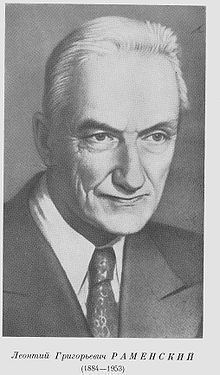Nationality Russia Role Plant scientist | Name Leonty Ramensky | |
 | ||
Born June 16, 1884Saint Petersburg ( 1884-06-16 ) Institutions All-union Scientific Research Institute of Forages dedicated to V.R.Williams Known for first formulating plant life strategiesplant indicator valuesecological gradient analysis | ||
Leonty Grigoryevich Ramensky (Russian: Leóntii Grigór'evich Rámenskii; June 16 [O.S. June 6] 1884 – January 27, 1953) was a Russian plant ecologist who conceived several important ideas that were overlooked in the West and later ’re-invented’ by western scientists.
He graduated from the Petrograd University in 1916 and obtained a Ph.D. in biology in 1935. From 1911 to 1928 he worked in the Research Institute of the Voronezh Gouvernement (now Voronezh State University) and from 1928 in the State Grassland Institute (later All-union Scientific Research Institute of Forages dedicated to V.R.Williams). Ramensky was a proponent of the view that biotic communities consist of species behaving individualistically (much like Henry Gleason in the U.S.A.). This was in strong contrast to the prevailing view of communities as super-organisms, held by the powerful V.N.Sukachov and his consorts (much like Frederic Clements in the U.S.A.). Hence, Ramensky was marginalized within the Russian scientific community and was only posthumously rehabilitated by Russian ecologists. Much later, the significance of his ideas was discovered by ecologists in the West.
Selected scientific works
1. Ramensky, L. G. (1929). K metodike sravnitel'noi obrabotki i sistematizatsii spiskov rastitel'nosti i drugih ob'ektov, opredelyaemih neskol'kimi neshodno deistvuyuschimi faktorami [On methods for comparative analysis and ordering of plant lists and other objects determined by multiple factors] (in Russian). Leningrad: Trudy Sovescaniya Geobotanikov-lugovedov. pp. 1–26.
In this work, Ramensky criticized the use of hierarchical classifications of plant communities and advocated ordination ("Ordnung") of communities (and other complex objects with multiple determining factors, such as soil profile and weather data) instead. He was explicit about assuming unimodal responses of species to underlying gradients in the environment. This was long before Correspondence analysis was first used (1952), the now classic applications of ordination to plant communities by J. Roger Bray and John T. Curtis and David W. Goodall and the theoretical foundations of gradient analysis was developed by Whittaker and others (1970s onwards).
2. Ramensky, L. G. (1938). Vvedenie v kompleksnoe pochvenno-geobotanicheskoe issledovanie zemel' [Introduction to comprehensive soil-plant studies of landscapes] (in Russian). Moskva: Sel'khozgiz. In this work, Ramensky proposed fundamental plant life strategies towards stress and disturbance. This work is a precursor of Grime's CSR strategy scheme.
3. Ramensky, L. G.; Tsatsenkin, I. A.; Cizikov, O. N.; Antipov, N. A. (1956). Ekologicheskaya otsenka kormovih ugodii po rastitel'nomu pokrovu [Ecological evaluation of grazed lands by their vegetation] (in Russian). Moskva: Sel'khozgiz. In this work, Ramensky and colleagues listed some 1,400 plant species from European Russia with tabulated quantitative indicator values for their tolerances for soil moisture, nutrients, grazing etc. This work is a precursor of Ellenberg’s widespread indicator values.
4. Ramensky, L. G. (1971). Problemi i metodi izucheniya rastitel'nogo pokrova. Izbrannie raboti [Problems and methods in the study of the plant cover: collected works] (in Russian). Leningrad: Nauka. This volume contains collected works of Ramensky.
